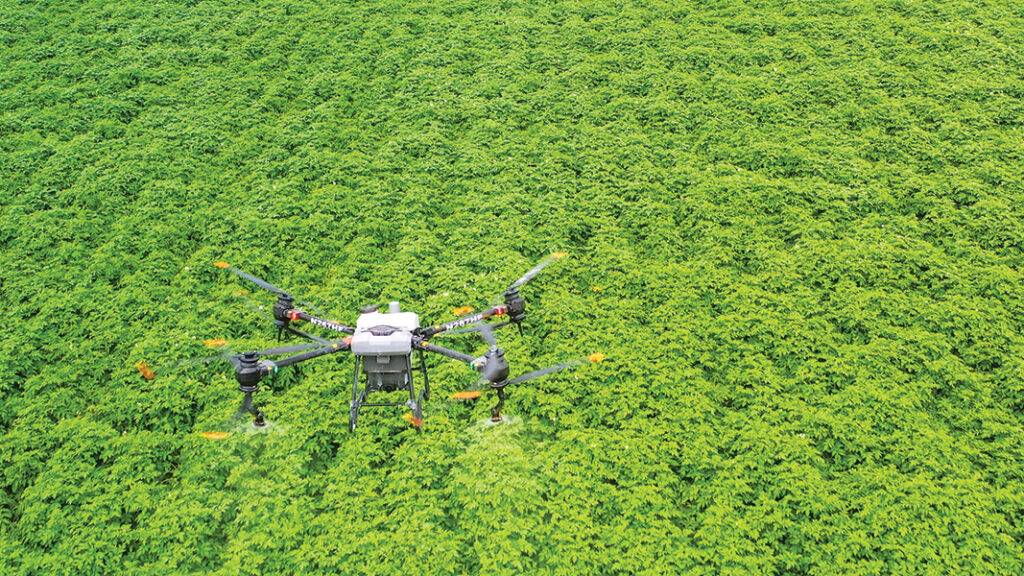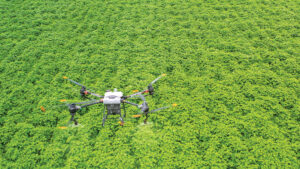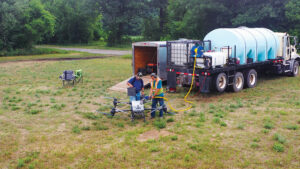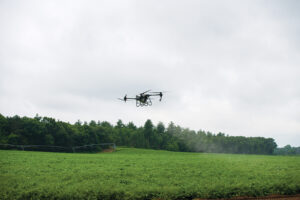
Emerging drone technology new tool to help manage crops
Unmanned aerial systems (UAS) — drones — are becoming more popular in grower operations. The devices are gaining a foothold in fields.
Drones are taking on more labor-intensive tasks as technology improves, allowing farmers to carry out traditional tasks like spraying for pests. They’ve also opened the door to new opportunities, efficiently gathering valuable data for comprehensive crop analysis and decision-making.

“Drones in agriculture overall have become more and more prevalent,” said Ittai Marom, general manager of Israel- based Tevel Aerobotics Technologies. “They are used for different operations, whether spraying or taking photos or fruit counting or disease detection, you name it. Drones have gained many capabilities. They can stay longer in the air and can carry more and more payloads of different kinds.”
Schneider Farms, a Pasco, Washington, grower of Russet french fry potatoes, uses drones as well as images from airplanes. “I can see troublesome areas before I go trampling all the way out to the field,” said Grant Morris, partner. “I’ll fly out there and just take a look at it to see if there’s a planter skip, or maybe a water hole or something. It’s just that you don’t need to go look at it, so it’s saved you some time there.
“It also helps with water management. They (drones) do everything that your eyeballs can do and it puts you in a lot of places that you can’t be. They can be pretty valuable sometimes.”
Farmers can also use drones to make more informed decisions in pest management, crop monitoring and resource allocation, said Chad Colby, agricultural technologist consultant to FlyingAg.com and owner of ColbyAgTech.com.
“This technology not only improves productivity and efficiency but also contributes to sustainable agricultural practices by reducing chemical inputs and optimizing resource utilization,” Colby said. “Drones are transforming the way farmers approach crop management, enabling them to achieve higher yields, reduce costs and enhance overall farm performance.”

Drones are a part of the large amount of technology Heartland Farms, a Hancock, Wisconsin grower of chipping and fresh potatoes, has adopted. Drones are an addition to GPS guidance, remote sensing, variable rate irrigation and telemetry for storage and irrigation, which allow growers to view all of their storages and pivots from their iPhones or iPads.
“Compared to 25 years ago, you had to manually go to each one of those,” said T.J. Kennedy, vice president of operations. “Our technology has made us faster, smarter and able to manage more.”
Because of a higher load capacity for carrying cameras, Morris said Schneider Farms is gaining more data from images supplied by airplanes. “Drones are not so much (used) in our area,” he said. “We have good access to regular normal aerial imagery. At the most basic level, you use a drone to fly out to a circle and check, to see what’s broken down and seeing the first view of trouble areas of the field.”
The technology is still developing at the technology company Schneider Farms was working with. “They’ve made great strides, but there’s still some work to be done in it, their apps,” Morris said. “It’s 100% the future, getting this technology stuff. They’re still working on the bugs and trying to get it all fine-tuned.”
Agricultural technology company Hylio manufactures UAS for precision crop treatment applications. The Houston-based Hylio helps growers apply crop treatments directly to problem areas, allowing growers to increase yields by addressing pests and deficiencies with more accuracy and efficacy, said Arthur Erickson, CEO and co-founder.
“The traditional methods for spraying are great, but if your ground is muddy, if you have an area, like a 5- or 10-acre patch of field that has a lot of fence lines or trees going through it, it’s going to be extremely difficult, if not downright impossible, for that tractor to get out and treat your crops,” Erickson said. “It’s a binary thing. It’s either a farmer wouldn’t have even treated these 20 or 30 acres. Now he can treat those 20 or 30 acres and get good yields out of them that he otherwise couldn’t even reach with his traditional equipment.
“Drones are unlocking applications that otherwise couldn’t even have been done with the current physical tools.”
Drones optimize crop scouting, which helps growers understand crop progress on a farm-wide scale, said Adityah Singh, assistant professor of agricultural and biological engineering at the University of Florida. While specialized sensors may be required for identifying specific issues, basic RGB or multispectral sensors can detect signs of wilting or changes in coloration and provide information to assess and monitor overall crop development, Singh said.
“Drones can be outfitted with thermal imagers to map crop canopy temperature, providing valuable insights into water stress,” Singh said. “Well-hydrated crops typically appear cooler due to evapotranspiration, making it possible to identify areas of concern. However, converting canopy temperatures into precise estimates of evapotranspiration or water demand requires further steps and is an active area of research at UF.”

The challenge of drone imagery is how to properly evaluate the data. Analytic tools are precise and should be calibrated so a grower can fly a drone from one orchard to another or even a neighbor’s property, and not receive inconsistent data, said Ali Pourreza, assistant professor and agricultural engineering Extension specialist at the University of California, Davis.
“Data collection is one part of the challenge, but data analytics is also an important part because if we get good data, but we don’t have a good algorithm, that data is useless and maybe even misleading,” Pourreza said.
Editor’s note: This is the first in a three-part series on drones, focusing on the rising use of drones in specialty ag operations and the growing number of tasks they can do. Future installments will look at costs and the pros and cons of owning versus leasing and what the future holds for drone technology.














